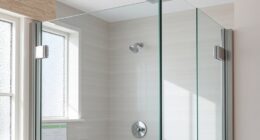Did you know that the average person spends about three years of their life on the toilet? That’s why it’s important to make the smart choice when it comes to our porcelain thrones.
In this article, we will compare smart toilets to traditional toilets, examining water efficiency, comfort and hygiene, smart technology, energy efficiency, maintenance and cleaning, design and aesthetics, and cost and affordability.
Get ready to dive into the world of smart toilets and discover which option is right for you.
Key Takeaways
- Smart toilets significantly reduce water usage and conserve water without compromising performance.
- Smart toilets provide a luxurious and hygienic experience with features like heated seats and bidet functions.
- Smart toilets come with automated functions like auto-flush, seat heating, bidet function, and odor control, enhancing convenience and improving user satisfaction.
- Smart toilets contribute to lower electricity bills and a reduced environmental footprint through energy-efficient components and features like motion sensors and sleep mode.
Water Efficiency: Comparing the Flush Systems
When it comes to water efficiency, we should compare the flush systems of smart toilets and traditional toilets. The flush mechanism in a toilet determines how much water is used with each flush, making it a crucial factor in water conservation.
Traditional toilets typically use a gravity flush system, where a large amount of water is released to create a force that pushes waste down the drain. This can result in excessive water usage, with each flush consuming around 1.6 to 3.5 gallons of water.
On the other hand, smart toilets are equipped with advanced flush mechanisms that are designed to maximize water efficiency. One popular type is the dual-flush system, which offers two options for flushing – a full flush for solid waste and a half flush for liquid waste. This allows users to choose the appropriate amount of water required, significantly reducing water usage. Smart toilets also incorporate technologies like pressure-assisted flush systems, where air pressure is used to create a powerful flush with less water.
Overall, smart toilets are a more water-efficient option compared to traditional toilets. By utilizing innovative flush mechanisms, they can help conserve water without compromising on performance. This makes them a smart choice for both the environment and your water bill.
Comfort and Hygiene: Analyzing Seat Features
As we consider the comfort and hygiene of the seat features, we can’t overlook the importance of a heated seat and a bidet function. These two features have revolutionized the way we use toilets, providing a luxurious and hygienic experience.
When it comes to toilet seat materials, manufacturers now offer a variety of options to suit different preferences. From durable plastic to high-quality ceramic, there’s a material for every taste and budget. The choice of material not only affects the aesthetics of the toilet, but also its durability and ease of cleaning.
Seat temperature control is another crucial aspect of modern toilet technology. No more sitting on a cold seat in the middle of winter! With heated seats, you can enjoy a warm and cozy experience every time you use the toilet. This feature is especially beneficial for individuals with sensitive skin or those who suffer from conditions like arthritis.
To provide a comprehensive cleaning experience, smart toilets now come equipped with bidet functions. This feature eliminates the need for toilet paper and offers a more thorough and hygienic cleanse. The adjustable water pressure and temperature settings allow users to customize their cleaning experience according to their preferences.
Smart Technology: Exploring Automated Functions
Let’s explore the various automated functions that come with modern smart toilets. These advanced toilets are equipped with innovative technology that allows for automated control and enhanced user experience. One of the key features of smart toilets is sensor technology, which enables hands-free operation and improved hygiene.
Here is a table that provides an overview of some common automated functions found in smart toilets:
| Automated Function | Description | Benefits |
|---|---|---|
| Auto-Flush | Automatically flushes the toilet after use | Promotes cleanliness and eliminates the need for manual flushing |
| Seat Heating | Warms the toilet seat for added comfort | Provides a cozy experience, especially during cold weather |
| Bidet Function | Offers a gentle water wash for personal hygiene | Enhances cleanliness and eliminates the need for toilet paper |
| Odor Control | Removes unpleasant odors from the toilet bowl | Creates a fresh and odor-free environment |
These automated functions enhance convenience and improve overall user satisfaction. With sensor technology, smart toilets can detect user presence and respond accordingly, making the bathroom experience more efficient and effortless.
Now that we’ve explored the automated functions, let’s move on to the next section about energy efficiency and understanding power consumption.
Energy Efficiency: Understanding Power Consumption
Understanding power consumption is essential in assessing the energy efficiency of smart toilets. These innovative bathroom fixtures offer various power saving features that not only reduce electricity usage but also have a positive environmental impact. Here are three key points to consider when it comes to power consumption and smart toilets:
-
Sensor Technology:
Smart toilets are equipped with motion sensors that detect when a person is using the toilet. This allows for automatic flushing, reducing water consumption. Additionally, the sensors also control the lighting and ventilation in the bathroom, ensuring that energy isn’t wasted when the room is unoccupied. -
Energy-efficient Components:
Smart toilets are designed with energy-efficient components, such as low-flow flushing mechanisms and LED lighting. These components consume less power compared to traditional toilets, resulting in lower electricity bills and a reduced environmental footprint. -
Sleep Mode:
Many smart toilets have a sleep mode feature that allows them to enter a low-power state when not in use for extended periods. This further reduces power consumption and contributes to energy savings.
Maintenance and Cleaning: Examining Ease of Use
When it comes to maintaining and cleaning smart toilets, ease of use is a crucial factor. We’ve examined the ease of use in terms of cleaning time and maintenance costs.
In the following points, we’ll compare the cleaning time required for smart toilets and traditional toilets, as well as analyze the potential maintenance costs associated with smart toilet systems.
Cleaning Time Comparison
In terms of cleaning time, smart toilets require less effort compared to traditional toilets. This is mainly due to their advanced features and innovative technology. Here’s why:
-
Self-cleaning capabilities: Smart toilets are equipped with self-cleaning mechanisms that eliminate the need for manual scrubbing. These mechanisms use powerful jets of water and cleaning agents to thoroughly clean the toilet bowl.
-
Anti-stain materials: The toilet bowl material used in smart toilets is often designed to resist stains and build-up. This means that less time and effort is required to remove any stubborn stains or residue.
-
Automatic flushing: Smart toilets have sensors that detect when the toilet is being used and automatically flush afterward. This not only reduces the need for manual flushing but also helps maintain a cleaner and more hygienic environment.
Overall, smart toilets provide a more efficient and hassle-free cleaning experience, saving you valuable time and effort.
Now, let’s delve into the next section and analyze the maintenance costs associated with these innovative fixtures.
Maintenance Costs Analysis
Now let’s delve into the maintenance costs analysis of smart toilets versus traditional toilets.
When it comes to maintaining a toilet, it’s essential to consider both the upfront expenses and the long-term costs. Smart toilets often come with advanced features, such as self-cleaning capabilities and automatic flushing, which can contribute to higher initial costs. However, these innovative functionalities can also reduce the time and effort required for cleaning, ultimately leading to lower maintenance expenses over time.
Additionally, durability analysis reveals that smart toilets are typically designed with high-quality materials that resist wear and tear, resulting in fewer repairs and replacements. This factor further contributes to the cost-effectiveness of smart toilets in the long run, making them a smart choice for homeowners looking to minimize maintenance costs while enjoying the benefits of modern technology.
Design and Aesthetics: Evaluating Style Options
We prefer the sleek and modern design of smart toilets over the traditional options. Smart toilets aren’t only highly functional but also aesthetically pleasing, adding a touch of sophistication to any bathroom.
When evaluating color options and assessing design trends, it’s important to consider the following:
-
Color options: Smart toilets come in a wide range of colors, allowing you to choose the perfect shade to complement your bathroom decor. From classic white to bold and vibrant hues, there’s a color option to suit every style and preference.
-
Minimalistic design: Smart toilets are designed with clean lines and a minimalist aesthetic, creating a sleek and uncluttered look. Their compact size makes them ideal for small bathrooms, maximizing space without compromising on style.
-
Innovative features: In addition to their stylish design, smart toilets offer a host of innovative features that enhance the overall user experience. From heated seats and adjustable water temperature to built-in bidets and self-cleaning functions, these toilets combine form and function seamlessly.
Cost and Affordability: Weighing the Price Tag
When considering cost and affordability, it’s important to weigh the price tag of different options.
When it comes to smart toilets versus traditional toilets, there are a few factors to consider. Firstly, the installation process of a smart toilet can be more complex and may require professional assistance. This can add to the overall cost of the smart toilet.
However, smart toilets often come with features such as self-cleaning capabilities and water-saving mechanisms, which can result in long term savings on water bills.
Traditional toilets, on the other hand, are generally more affordable in terms of upfront costs and installation. However, they may not have the same energy-efficient features as smart toilets, which means you may miss out on potential long term savings.
Ultimately, the decision between a smart toilet and a traditional toilet should be based on your budget and long term goals.
If you prioritize cutting-edge technology and energy efficiency, a smart toilet may be worth the investment despite the higher initial cost. However, if affordability is your main concern, a traditional toilet may be the more practical choice.
Frequently Asked Questions
Are Smart Toilets More Expensive Than Traditional Toilets?
Smart toilets cost more than traditional toilets, but they offer several benefits that make them a smart choice.
The additional features of smart toilets, such as bidet functionality, heated seats, and automatic flushing, contribute to their higher price tag. However, these features provide increased comfort, hygiene, and convenience.
Smart toilets also often include advanced technology like touchless controls and water-saving options.
While they may be more expensive upfront, the long-term benefits and improved user experience make them a wise investment.
Can Smart Toilets Be Easily Installed in Older Homes?
Installing smart toilets in older homes can pose challenges due to retrofitting and plumbing compatibility. Retrofitting can be difficult as older homes may not have the necessary electrical wiring or plumbing infrastructure to support smart toilet technology.
Additionally, plumbing compatibility can be an issue as older homes may have different pipe sizes or configurations that may not be compatible with smart toilets.
It’s important to consult with a professional plumber to assess the feasibility and cost of installing a smart toilet in an older home.
How Often Do Smart Toilets Require Maintenance?
Smart toilets, when it comes to maintenance frequency, differ from traditional toilets. They require less maintenance due to their advanced technology. With features like self-cleaning capabilities and automatic flushing, the need for manual cleaning and maintenance is significantly reduced. This not only saves time and effort but also ensures a more hygienic and convenient bathroom experience.
The benefits of smart toilet technology go beyond maintenance, offering increased comfort, water conservation, and personalized settings for users.
Can Smart Toilets Be Connected to a Home Automation System?
Integrating smart toilets with a home automation system offers numerous benefits. It allows for seamless control and customization of toilet functions, such as flushing and bidet settings.
Additionally, it provides real-time monitoring of water usage and leak detection. However, there are challenges in connecting smart toilets to a home automation system, such as compatibility issues and the need for a reliable and secure network connection.
Overall, the integration can enhance convenience and efficiency in managing toilet operations within a smart home.
Do Smart Toilets Have Any Additional Safety Features?
Smart toilets offer a range of safety features that traditional toilets don’t. These features include motion sensors that automatically lift the toilet lid when someone approaches, preventing any messy accidents. Additionally, smart toilets often come equipped with built-in bidets and adjustable water temperature settings, ensuring a hygienic and comfortable experience.
Conclusion
In conclusion, when it comes to choosing between smart toilets and traditional toilets, it’s clear that smart toilets offer numerous advantages.
From their water and energy efficiency to their automated functions and ease of maintenance, smart toilets are a smart choice for any household.
As the saying goes, ‘A little investment now saves a lot in the long run.’
So, invest in a smart toilet today and enjoy the benefits of modern technology and convenience for years to come.



